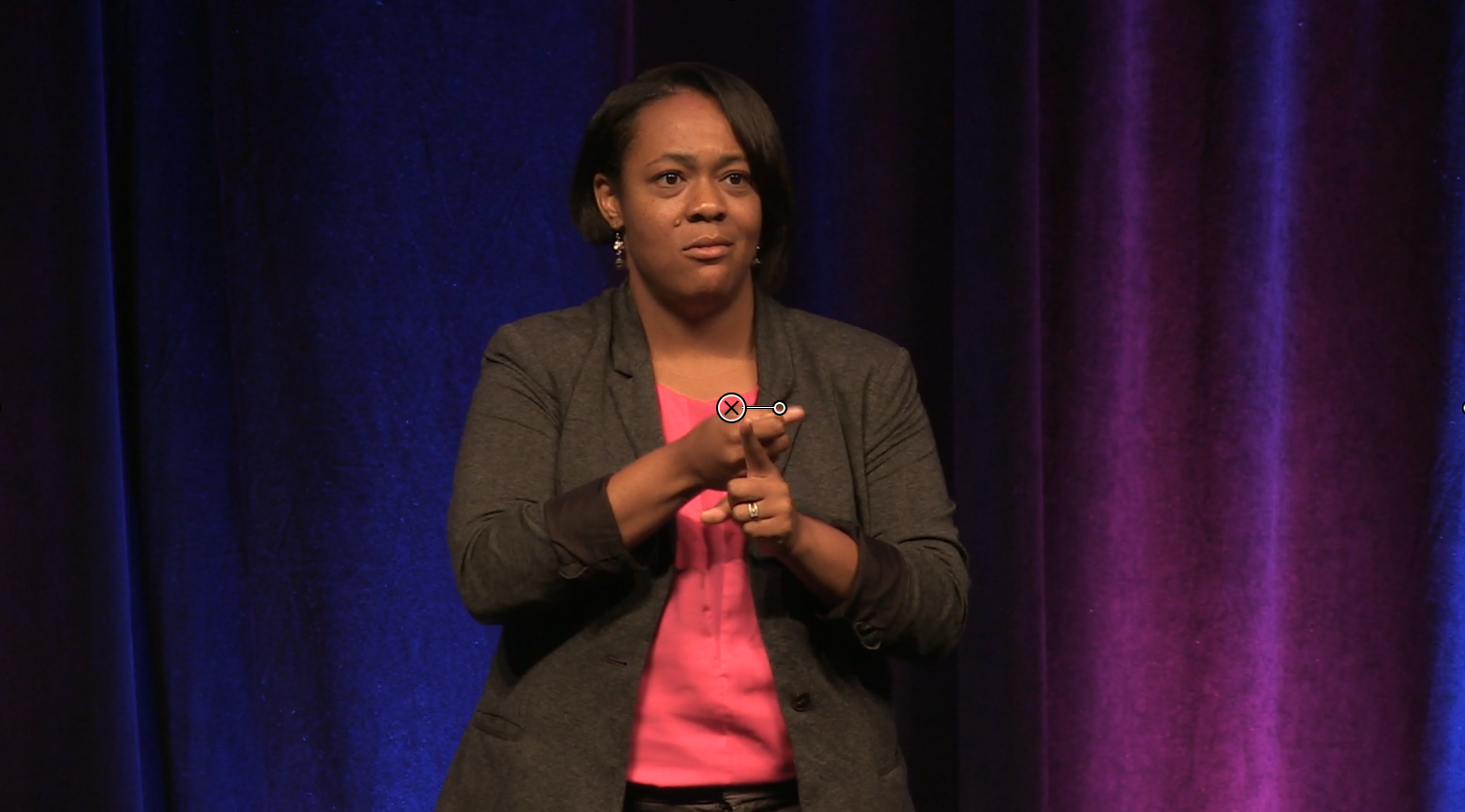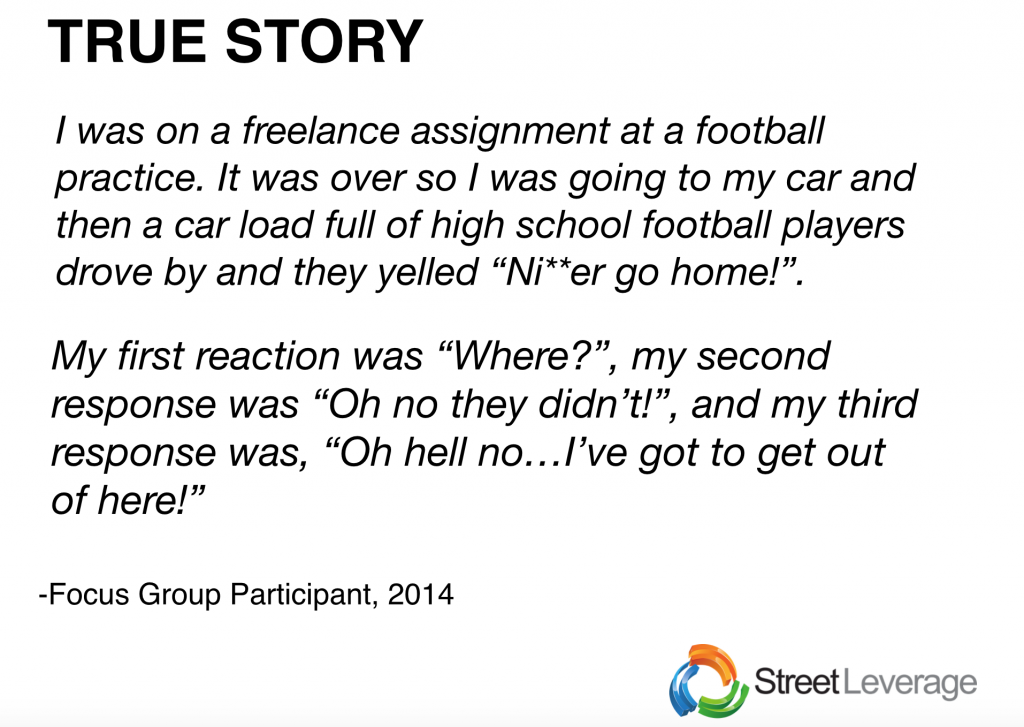
Students of Color in interpreter education programs (IEPs) need encouragement. MJ Jones outlines some critical ways we can support future Interpreters of Color through mentorship, support, and information-sharing.
Introduction
As a hearing transgender Interpreter of Color, I often wonder where to find sign language interpreters and Deaf people who look like me. Sometimes, it feels as if my multiple identities make it a challenge to build connections, seek mentors, and feel my authentic self in the field of sign language interpreting. It was not until my experience attending the Deaf People of Color Conference last year in Austin, TX, where I felt valued for all my intersectional identities, especially as an interpreting student of color. This optimal space provided opportunities to build new connections with Deaf People of Color, from scholars to academic leaders, and members of multiple communities. I met Deaf people, Deaf-Blind individuals, a Deaf Transgender woman, and sign language interpreters, all of whom identified as People of Color. The connection with folks who shared similar cultural and racial backgrounds was a feeling I have yearned for since I first started learning sign language. Building connections with Deaf People of Color and networking with other interpreters of color allowed me to feel I could bring my many authentic selves to the field of sign language interpreting.
Months later, at the National Association of the Deaf (NAD) Biennial conference, NAD recognized Deaf youth ambassador, Tanea Brown, for her strategic plan to address the lack of interpreters of color within the Deaf Community. Watching Tanea’s presentation, I felt a renewed connection and inspiration from her vision to create pathways for interpreters of color. In her presentation, Tanea shared,
When we look at minority communities, we don’t find as many opportunities for them [Students of Color] to pursue interpreting as a career, which in the end really impacts the Deaf community and Deaf People of Color. So we need to educate minority communities and create a pathway for them to pursue interpreting as a viable career.
Creating pathways for sign language interpreters cannot be done without support and mentorship. Evidently, this issue is not only critical for aspiring Interpreters of Color but to Deaf People of Color. Uncovering the experiences of interpreting Students of Color will allow us to understand the kind of support and mentorship interpreting Students of Color need to succeed. This series installment aims to discuss how mentorship and professional information can benefit pathways for interpreting Students of Color with narratives from our research (click here for more information about our research) and from conversations with colleagues who recently graduated.
Lack of Professional Information
Being a Black-Filipinx interpreter, both Erica West-Oyedele and Christine Nakahara provide amazing narratives that discuss the experiences of Black (West-Oyedele) and Asian Heritage (Nakahara) sign language interpreters. In the collective narratives, participants mentioned organizations they wish they knew about or had access to, such as National Black Deaf Advocates (NBDA), the National Alliance of Black Interpreters (NAOBI), and the National Asian Deaf Congress (NADC). This is parallel to what we found in our research as only a few students mentioned these organizations by name.
Within our research, students from California State University, Northridge (CSUN) (see part 3 of the series) who shared they did not have much support or encouragement also did not have access to Deaf events. In addition, they recognized the lack of diversity and connection in classrooms and the broader field of sign language interpreting. Furthermore, one student shared they were not interested in the field because of the lack of information available regarding pathways to obtaining advanced degrees (i.e., M.A, and Ph.D. programs). A Persian-Jewish female student who did not pursue a career in sign language interpreting shared, “It was a family expectation for me to get a master’s degree and I thought that if I became an interpreter that would be it. There is no more training. That wasn’t enough for me.” While the lack of access to professional information and organizations was prevalent for study participants, many of them also mentioned the struggle to obtain mentorship.
Lack of Mentorship
Mentorship plays a large role when analyzing the field of sign language interpreting and students’ experiences. Students who applied but were not accepted into the interpreting program did not have supported paths to meet Deaf People of Color (POC), mentors, or other peers to support them (click here for part 3 in the series). They expressed not developing an interest because of the lack of Interpreters of Color at events When an interpreter does not see other sign language interpreters who look like them, they often feel isolated if they are the only one from that racial/ethnic group. After asking a recent graduate, a Cisgender Queer Female, about her experience, she shared, “For me, I feel I haven’t had a Filipino interpreter mentor. It feels kind of isolating because I feel like I’m the only one able to represent this demographic.”
Clearly, Students of Color (SOC) aren’t only lacking knowledge about how to find and access professional information, but they are also lacking access to mentors of color. Spaces where sign language interpreting students of color can get support from Deaf POC and interpreters are critical to their persistence in the field and to their identity as Interpreters of Color. As West-Oyedele’s (2015) study reveals, “Interpreters of Color felt welcomed among Black Deaf consumers and created spaces with other African American/Black interpreters in the form of task forces or other social groups that allowed them to connect and be themselves” (p. 69). Connecting back to my experience at the Deaf People of Color Conference, I realized not many Students of Color (SOC) have exposure to Deaf individuals and sign language interpreters who identify like them.
Lack of Support and Encouragement
Support can come in different shapes and forms. Our research revealed that SOC who were successful in their interpreter training programs had a great deal of social capital. For SOC, social capital includes various resources and support from the community that supports an individual’s growth as an interpreter. This includes support from ASL educators, hearing and Deaf interpreters, mentors, support from interpreting and D/deaf organizations, and even support from family, peers, friends to pursue sign language interpreting as a career. In order to get a better understanding of support in the classroom, I asked a colleague who recently graduated from an IEP.
My first colleague, a cisgender Haitian-American man, shared:
I got support from a few students in my school’s program. I had one particular classmate who became like a brother to me. I knew I could depend on him for support at any time of [the] day if I needed. I definitely could not depend on my department to provide the support I needed because a lot of the time I was there as a token. Luckily, we [had] gatherings with all the students of color each semester to vent in a safe space about our issues or just to hang out and be ourselves.
If students feel they are unable to get support from within the department, they find support in other ways. Additionally, providing a space for SOC to gather provides them opportunities to connect and develop their own support systems. Study participants who did not apply or were not accepted into the interpreting program reported that they did not have strong social capital.
Pathways to Mentorship and Guidance
Even with the lack of information and support provided for SOC, students who succeeded found pathways to mentorship and guidance. We found that students who experienced the most success developed connections with unofficial mentors prior to attending. One research participant, a cisgender female Latino and queer-identifying student shared, “My high school ASL teacher was Latino and queer. He had the same identities as me. He told me about CSUN and encouraged me to be an interpreter.” In this case, intersectionality comes into play as the student identifies with their teacher racially and with another identity (i.e., language, sexual orientation, and gender). In situations like this, sharing two or more similar identities allows for stronger connections and more support. As a Trans POC, it was most difficult for me to find an LGBTQ POC in order to have those conversations. Once I did, I had deep conversations about how to navigate the field with my intersections, particularly when my race, gender, and sexual orientation are opposite from the main narrative.
While some students had mentors whom they identified as white, some students shared they realized certain conversations and topics were more difficult to discuss with white mentors. Especially, when talking about challenges in regards to race, culture, appearance (i.e., hair and best clothing), and microaggressions. Students did not feel comfortable with sharing those topics with white mentors. My first colleague shared:
I remember I asked another assigned mentor, who was a white cisgender male, his opinion of my hair. Once my question came out of my mouth, I realized that there could be so many things that could come out wrong with his answer. Fortunately, his response was appropriate, but I would have liked to have that conversation [about my hair] with people in my own community.
These stories do not necessarily mean mentors who are white are not a good match for SOC but indicate that students may feel more comfortable having conversations about their experience of race and culture with IOC.
Another common trend identified was students reaching out to IOC outside of their program during their course of study. Often there are only a few SOC and Faculty of Color around the department for SOC to reach out for support. For example, my second colleague, a cisgender Filipino queer female shared:
Some of the support outside of the program was from different interpreters of color encouraging me to continue my journey and not to easily give up because of the overwhelming appearance of our demographic being outnumbered by the dominant non-POC interpreters.
As we look at the current Registry of Interpreter for the Deaf (RID) statistics, this is not surprising. A recent number shows that 86% of certified interpreters identify as Euro-American/White interpreters (RID Annual 2016 Report). Sharing a cultural background or lived experiences can be a catalyst for a deeper connection and trust between mentor and student, which increases performance and motivation. In our research, the evidence seems to indicate that students who pursued sign language interpreting felt more comfortable and persisted because of the connections and mentorship relationships they had built before and during the program.
Conclusion
It is our collective responsibility to incorporate more diversity and support for Students of Color as they explore fields related to sign language interpreting and the Deaf Community. Whether one is creating online space for students of color and alumni of a program to connect and share resources or hosting gatherings for Students/Interpreters and Transliterators of Color, or connecting with local Deaf People of Color organizations, there is much that can be accomplished. As stakeholders, educators, sign language interpreting agencies, seasoned and newer interpreters, know that you can be an agent of change. Supporting one another allows us to do better work and allows our consumers to receive the best possible services.
In order to continue this discussion, here are some questions to consider:
- How do Interpreting Training Programs support Heritage Signers of color, Deaf Interpreters of color, Trilingual students of color?
- How do we lessen the feelings of ‘tokenism’ when there are a small number of students of color in a program?
- How do we create authentic spaces in our IEP’s that allow all students to feel authentic and valued?
- How do we become more intentional about matching mentors with students of color? If we don’t have access to interpreters of color, what ways are we providing professional information and mentors that allow them to build connections with seasoned interpreters of color?
- When seeking to open student’s minds, how do we incorporate conversation of power, privilege, and oppression to dismantle structures of knowledge?
References
Nakahara, C. (2016). “Expanding the collective narrative: Exploring the experiences of American Sign Language/English Interpreters of Asian Heritage.” [Dissertation]
National Association of the Deaf – NAD Facebook Live (July 8th, 2016). #NADYAP Final Round #NAD2016 Conference. Retrieved from https://www.facebook.com/NAD1880/videos/10154281217063810/
Registry of Interpreter for the Deaf (RID). (2016). 2016 Annual report change. Renewal, Recovery. Retrieved from http://rid.org/2016-annual-report/
West Oyedele, E. (2015)., “Persistence of African-American/Black signed language interpreters in the United States: The importance of culture and capital” [Dissertation].
Other Contributors to this Series:
Dr. Lissa D. Ramirez-Stapleton
Lissa D. Ramirez-Stapleton is an associate professor at California State University Northridge in the Department of Deaf Studies and core faculty for the Educational Leadership and Policy Studies program. Her research focuses on equity and access, identity development, and the educational history of Deaf students, faculty, and staff with a particular interest in the intersections of race, gender, and disability. www.drlissad.com
Dr. Will Garrow
Will Garrow, Ph.D. (pronouns: he/him/his) is from upstate New York, where he was first introduced to the Deaf Community through his career as a professional snowboarder. All of his degrees are from Gallaudet University with a Bachelor of Arts in Deaf Studies, a Master of Arts in Linguistics, and a doctorate in Linguistics. As a faculty member at California State University, Northridge, his teaching mainly focuses on how oppression works in American society, Deaf Culture, and ASL Linguistics. When Will is not teaching, he can be found either on the snow in the mountains or splatting balls in the racquetball court.
Jasmine Solis
Jasmine Solis (pronouns: she/her/hers), originally from Orange County California, received her B.A. in Deaf Studies with a concentration in Interpreting from California State University, Northridge (CSUN). As a recipient of the CSUN Presidential Scholarship, Jasmine completed her research unpacking confidence levels and anxiety amongst Students of Color who are currently or planning to pursue interpreting. Now as the full-time Academic Advisor for the Deaf Studies Department at CSUN, Jasmine hopes to continue supporting and encouraging students to reach their career goals.





